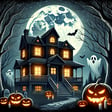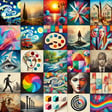🎃Practical Work in AI : Crafting HALLOWEEN2024 -Themed Promots,Parameters,Writing and Training .
👻👻 Practical Work in AI: Crafting Halloween-Themed Prompts, Parameters, Writing, and Training Experiments👻👻🎃Introduction🎃Halloween offers a vast creative landscape for AI-driven content, from spooky stories to eerie images. In this article, we’ll explore the practical application of AI in generating Halloween-themed outputs by focusing on prompt engineering, parameter tuning, and writing experiments. We will also generate a Halloween-themed image based on a prompt, demonstrating the process.🎃1. Prompt Words: Setting the Halloween MoodTo create a Halloween-themed AI output, the prompt words must evoke the spooky, eerie atmosphere associated with the holiday. Let’s start with a simple prompt and explore how adding more descriptive language enhances the result.Basic Prompt:- "A haunted house on Halloween night."This will likely generate a simple image or text description of a haunted house, but it can be enriched for more detail:Detailed Prompt:- "A dark, abandoned mansion on a foggy Halloween night, with glowing pumpkins lining the porch, and ghosts swirling around the windows. The full moon casts eerie shadows on the cracked walls, and bats circle the sky."This more intricate prompt will guide the AI to create a detailed, atmospheric Halloween scene filled with iconic Halloween symbols like pumpkins, ghosts, and bats.🎃2. Parameters: Adjusting for Creativity and SpookinessWhen generating content, parameters help control aspects of the output. Here’s a look at two key parameters:- Temperature: In writing and image generation, temperature can affect how “creative” the model becomes. For Halloween, a higher temperature (e.g., 0.7 or above) can lead to unexpected, eerie results, while a lower temperature (0.2) might produce more predictable, formulaic outputs. Example with different temperatures: - Temperature 0.2: "The haunted house stands in darkness, with broken windows and a cracked roof." - Temperature 0.8: "The haunted house looms with twisted shadows, its windows flickering with ghostly light. A chill in the air whispers of long-forgotten souls."- Max Tokens: This parameter controls the length of text generation. A short story versus a longer narrative about a haunted mansion will be influenced by this setting.🎃3. Writing Experiments: Crafting a Halloween StoryTo guide AI into creating an engaging Halloween story, it’s useful to break down the prompt into sections, directing the model to write in stages. Here’s an example prompt for a short Halloween story:Prompt: "Write a story about a group of friends who discover an ancient, cursed book on Halloween night."This can be broken down into:- Act 1: The group of friends finds the book in an old, dusty library.- Act 2: Strange and terrifying things start happening as they read the book.- Act 3: They realize the book has unleashed a terrible curse that they must break before midnight.Using a step-by-step breakdown helps structure the story, ensuring that the AI follows a coherent narrative while building suspense and tension — key elements in any Halloween tale.🎃4. Training Experiments: Enhancing AI’s Halloween KnowledgeTraining experiments involve curating data to train models on specific themes, like Halloween. If you wanted to fine-tune an AI to specialize in Halloween content, you could train it on a variety of horror literature, classic Halloween imagery, and even audio cues like spooky sound effects.For example:- Text training data: Horror stories from authors like Edgar Allan Poe or Stephen King.- Image training data: Pictures of haunted houses, creepy forests, and Halloween decorations.By using these types of materials, AI becomes better at recognizing and generating content that fits the spooky, Halloween theme.Image Creation ExampleNow, let’s create an AI-generated Halloween-themed image based on a detailed prompt.Halloween-Themed Prompt:"A creepy, abandoned house at the edge of a dark forest on Halloween night. Jack-o'-lanterns with glowing eyes sit on the steps, and a full moon lights up the sky. Ghosts hover near the windows, and bats fly above the rooftop."The generated image above captures the spooky Halloween scene from the prompt, with an abandoned house, glowing jack-o'-lanterns, ghosts, and bats under a full moon. This demonstrates how a well-crafted, detailed prompt can guide AI to create a specific visual mood.So,In AI-driven creative tasks, prompt engineering, adjusting parameters, and experimenting with training data are essential tools. By carefully selecting prompt words and tuning parameters, we can evoke the perfect Halloween atmosphere, whether in writing or visual form. As seen in this example, a rich, descriptive prompt can lead to vivid, atmospheric results for any Halloween project.#HALLOWEEN2024












